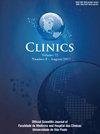Biliary HMGB1 levels and biochemical indices in the assessment of acute obstructive septic cholangitis combined with septic shock
IF 2.4
4区 医学
Q2 MEDICINE, GENERAL & INTERNAL
引用次数: 0
Abstract
Background
Acute Obstructive Septic Cholangitis (AOSC) is a serious infectious disease of the biliary system. It is prone to develop into septic shock without prompt management.
Methods
Bile was collected from 71 AOSC patients (45 AOSC without septic shock, 26 AOSC with septic shock) during biliary drainage and on days 1 and 3 postoperatively. The levels of High Mobility Group Protein 1 (HMGB1), Interleukin (IL)-1, IL-6, and Tumor Necrosis Factor alpha (TNF-α) were measured. The differences in the levels of biliary factors and their correlation with clinical biochemical indicators were assessed in the two groups.
Results
HMGB1 gradually decreased in both groups in the postoperative period. Intraoperative levels of biliary HMGB1 were significantly higher in patients with AOSC with septic shock. TNF-α and HMGB1 decreased slowly in patients with AOSC with septic shock on postoperative days 1 and 3, and the levels of the factors decreased less. Biliary HMGB1 levels were negatively correlated with white blood cell count and positively correlated with blood urea nitrogen, blood creatinine, procalcitonin, and C-reactive protein. A bile HMGB1 level of 1108.3 pg/mL was the cut-off value to differentiate patients with AOSC with or without septic shock.
Conclusion
Biliary HMGB1 levels are elevated in patients with AOSC with septic shock and decrease slowly in the postoperative period. This suggests that HMGB1 is of considerable importance as a potential therapeutic target in the pathogenesis of septic shock in AOSC patients.
胆道HMGB1水平及生化指标在急性梗阻性化脓性胆管炎合并感染性休克中的评价
背景急性梗阻性化脓性胆管炎(AOSC)是一种严重的胆道系统感染性疾病。如不及时处理,极易发展为感染性休克。方法收集71例AOSC患者(无感染性休克的AOSC患者45例,有感染性休克的AOSC患者26例)在胆道引流时及术后第1、3天的胆汁。测定高迁移率组蛋白1 (HMGB1)、白细胞介素(IL)-1、IL-6、肿瘤坏死因子α (TNF-α)水平。观察两组患者胆道因子水平的差异及其与临床生化指标的相关性。结果两组患者术后shmgb1水平逐渐降低。AOSC合并感染性休克患者术中胆道HMGB1水平明显升高。AOSC合并脓毒性休克患者TNF-α和HMGB1在术后第1天和第3天下降较慢,且下降幅度较小。胆道HMGB1水平与白细胞计数负相关,与血尿素氮、血肌酐、降钙素原、c反应蛋白正相关。胆汁HMGB1水平为1108.3 pg/mL,是区分AOSC合并或不合并感染性休克的临界值。结论AOSC合并感染性休克患者胆道HMGB1水平升高,术后下降缓慢。这表明HMGB1在AOSC患者脓毒性休克发病机制中作为潜在的治疗靶点具有相当重要的意义。
本文章由计算机程序翻译,如有差异,请以英文原文为准。
求助全文
约1分钟内获得全文
求助全文
来源期刊

Clinics
医学-医学:内科
CiteScore
4.10
自引率
3.70%
发文量
129
审稿时长
52 days
期刊介绍:
CLINICS is an electronic journal that publishes peer-reviewed articles in continuous flow, of interest to clinicians and researchers in the medical sciences. CLINICS complies with the policies of funding agencies which request or require deposition of the published articles that they fund into publicly available databases. CLINICS supports the position of the International Committee of Medical Journal Editors (ICMJE) on trial registration.
 求助内容:
求助内容: 应助结果提醒方式:
应助结果提醒方式:


